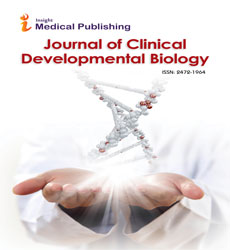Problems Associated with Dialysis
Rakshitha Kotha
Rakshitha Kotha*
Department of Biochemistry, Osmania University, Hyderabad, Telangana, India
- *Corresponding Author:
- Rakshitha Kotha
Department of Biochemistry
Osmania University, Hyderabad, Telangana, India
Tel: +32-466-90-05-61
E-mail: raksh32311@gmail.com
Received Date: October 09, 2021; Accepted Date: October 23, 2021; Published Date: October 30, 2021
Citation: Rakshitha K (2021) Problems Associated with Dialysis. J Clin Dev Biol. 6:04.
Commentary
Problems associated with dialysis
Kidney illness causes waste to build up in the body because the kidneys are damaged and unable to filter blood effectively. Kidney disease makes you more likely to have a stroke or a heart attack. End-stage renal disease (ESRD) is a type of kidney failure that can only be treated with a transplant or dialysis. Diabetes, hypertension, and a family history of renal failure are all major risk factors for kidney disease. In the United States, around 661,000 people have kidney failure, with 468,000 on dialysis and 193,000 having a functioning kidney transplant.
Vascular access in hemodialysis patients and abdominal catheters in individuals on continuous ambulatory peritoneal dialysis are linked to a variety of problems (CAPD). These vascular access complications are the same as those observed in any patient undergoing vascular surgery (e.g., bleeding, local or disseminated intravascular infections [DIC], vessel [graft] occlusion)
Side effects are common with both haemodialysis and peritoneal dialysis. This is due to the way dialysis is performed and the fact that it can only compensate for a portion of renal function loss.
Haemodialysis side effects:
• Blood pressure that is too low.
• One of the most prevalent side effects of haemodialysis is low blood pressure (hypotension).
• The decline in fluid levels during dialysis can cause it. Nausea and dizziness are symptoms of low blood pressure.
• Maintaining your daily fluid consumption requirements is the greatest strategy to reduce these low blood pressure symptoms.
Peritoneal dialysis side effects:
• Inflammation of the peritoneum.
• Bacterial infection of the peritoneum is a typical side effect of peritoneal dialysis (peritonitis).
If the dialysis equipment is not kept clean, peritonitis might develop. Bacteria can spread to the peritoneum, the thin layer of tissue that lines the lining of the abdomen, if bacteria are present on the equipment.
Dialysis complications, both acute and chronic: Hyper-kalemia, hypo-calcemia, hypo-natremia, and hyper-magnesemia are among them. Headache, dialysis dementia, dialysis disequilibrium syndrome, Wernicke's encephalopathy, and stroke are among neurologic problems that can arise either directly or indirectly as a result of hemodialysis.
Infections are a common problem in hemodialysis patients
In the dialysis population, HVAD is the most common source of infection. Erythema, skin disintegration, purulent discharge, and bleeding from a pseudo-aneurysm are all signs of infection. There may be a fever and other indicators of sepsis.
The common effects
Hypotension is a condition in which the blood pressure (Low blood pressure): This has to do with how quickly and how much fluid is eliminated from your blood. This can readily be reversed by administering intravenous fluids. Symptoms might range from mild to severe. If you experience dizziness, nausea, leg cramps, or any other 'weird sensation,' tell the nurse.
Overflow of fluids: Patients may experience a condition known as fluid overload in between treatments. This is caused to a build-up of fluid in your body. Swollen ankles, elevated blood pressure, and extreme dyspnea are all symptoms of fluid overload.
The access point is bleeding: The needles in your fistula or graft will be removed after dialysis. Before you leave the unit, your nurse will make every effort to ensure that the bleeding has stopped.
Potassium deficiency: Hyperkalaemia is the medical word for this. This indicates that the blood has too much potassium. This is potentially life-threatening.
Open Access Journals
- Aquaculture & Veterinary Science
- Chemistry & Chemical Sciences
- Clinical Sciences
- Engineering
- General Science
- Genetics & Molecular Biology
- Health Care & Nursing
- Immunology & Microbiology
- Materials Science
- Mathematics & Physics
- Medical Sciences
- Neurology & Psychiatry
- Oncology & Cancer Science
- Pharmaceutical Sciences
